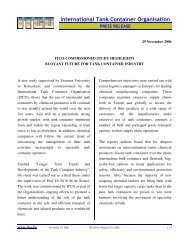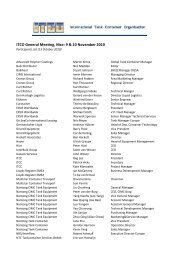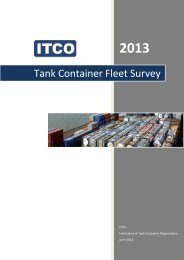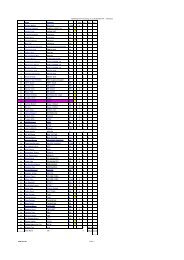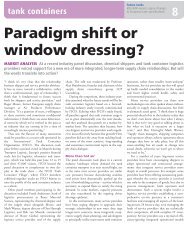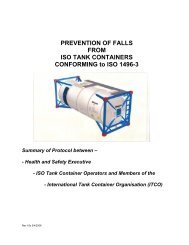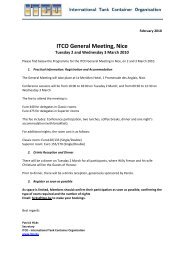You also want an ePaper? Increase the reach of your titles
YUMPU automatically turns print PDFs into web optimized ePapers that Google loves.
ICHCA International <strong>Safe</strong>ty Panel Briefing Pamphlet No 30<br />
perhaps when the tank container has moved from an extremely cold climate<br />
to a warmer one causing snow and ice to melt.<br />
5.3.6.4 On some tank containers the storm door(s) cover the pressure relief valve.<br />
The dangerous goods regulations require the vapour escaping from the<br />
relief valve to be discharged unrestrictedly. If the escaping vapour is<br />
flammable, there is a further requirement that the vapour must be directed<br />
away from the shell in such a manner that it cannot impinge on it (see<br />
paragraph 6.7.2.15.1 <strong>of</strong> the IMDG Code). <strong>Tank</strong> containers fitted with storm<br />
doors which restrict the flow <strong>of</strong> escaping vapour and, particularly if the doors<br />
will direct escaping flammable vapour back down onto the tank shell, should<br />
not be accepted for carriage.<br />
5.4 Fittings (bottom <strong>of</strong> shell)<br />
5.4.1 Bottom Outlet Assemblies<br />
5.4.1.1 Bottom outlet assemblies permit the filling but more importantly the<br />
discharge <strong>of</strong> tank containers. The dangerous goods regulations provide for<br />
three levels <strong>of</strong> protection on outlet assembly configuration depending on the<br />
nature <strong>of</strong> the cargo.<br />
5.4.1.2 Bottom outlet not allowed<br />
5.4.1.2.1 Certain cargoes must not be discharged from a bottom valve. These are<br />
covered by the portable tank instruction designation T5, T8, T9, T10, T13,<br />
T14 and T19 to T22. There should be no bottom outlet arrangement on<br />
tanks carrying such cargoes, or where previously fitted, the valve(s) must<br />
be removed and the opening in the shell plated over as described in<br />
paragraph 5.3.5.1.<br />
5.4.1.3 Two serial devices<br />
5.4.1.3.1 For cargoes with a designation T1, T3 and T6 there must be at least two<br />
serially mounted and mutually independent shut <strong>of</strong>f devices fitted within<br />
the bottom valve assembly.<br />
5.4.1.3.2 The first closure will <strong>of</strong>ten be a valve which closes inside the shell,<br />
usually call the “foot valve” (see Picture 29), or an externally closing<br />
butterfly valve (see Picture 30). External valves are more usual in the<br />
case <strong>of</strong> tank containers with just two closures. The second closure would<br />
then generally be a threaded cap (see Picture 31) or a bolted blank<br />
flange.<br />
5.4.1.3.3 However with only three cargo designations permissible with the two<br />
serial device valve assembly, the majority <strong>of</strong> tank containers will be fitted<br />
with three serial devices to increase the number <strong>of</strong> regulated cargoes<br />
permitted to be carried.<br />
5.4.1.3.4 The dangerous goods regulations allow for products which easily<br />
crystallise or which are viscous to be transported in bottom discharge<br />
portable tanks with only two closures. However, competent authority is<br />
required when this option is used (see, for example, paragraph 6.7.2.6.2<br />
in the IMDG Code).<br />
Page 14 ©ICHCA International Limited



